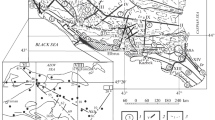Abstract—
Modeling of the most common types formation of anticlinal and uplift-thrust tectonic structures was carried out with using optical polarization and tectonic-sedimentary methods based on seismic sections analysis of various areas and deposits located in the West Siberian oil and gas basin that were selected for examples. Experiments with using the optical-polarization method allowed us to research the nature of the stress-regime arising in the gelatin models of the sedimentary cover due to the growth of anticlinal blocks and uplift-thrust dislocations. By the level of tangential stresses and orientation of isoclines in optical models, zones of probable tectonogenic fracture and the direction of cracks are predicted. 2D tectonic-sedimentation modeling made possible to explain the mechanism of formation of “rootless” uplifts, zones of subsidence or decompression in sediments, the principle of tectonic “pump” function, and to obtain dependencies between size and shape of uplift, density and opening of cracks formed above, to calculate the value of fracture “porosity”, as well as lateral dimensions of zones of tectonogenic fracturing. 3D tectono-sedimentation modeling allowed to link hydrography of the earth surface of the simulated area with decompression of zones that came to the surface in the models. These zones of decompression can serve as a search sign for exploration of highly productive zones containing hydrocarbon deposits.












Similar content being viewed by others
REFERENCES
V. V. Belousov and M. V. Gzovskii, Experimental Tectonics (Nedra, Moscow, 1964) [in Russian].
P. M. Bondarenko and I. V. Luchitskii, “Strike-slips and shear zones in tectonic stress fields,” in Experimental Tectonics in Theoretical and Applied Geology, Ed. by I. V. Luchitskii and P. M. Bondarenko (Nauka, Moscow, 1985), pp. 159‒182.
M. V. Gzovskii, Fundamentals of Tectonophysics (Nauka, Moscow, 1975) [in Russian].
M. Yu. Zubkov and P. M. Bondarenko, “Prediction of secondary jointing zones on the basis of seismic survey and tectonophysical modeling,” Geol. Nefti Gaza, Nos. 11‒12, 31‒40 (1999).
M. Yu. Zubkov, P. M. Bondarenko, Ya. A. Trukhan, and A. G. Lazarev, “Prediction of hydrocarbons in cracked pools of the Bazhenovo and Abalak formations. East Pal’yanovo area, from the results of seismic survey and tectonophysical modeling,” in Ways to Recover Potential Petroleum Resources of the Khanty-Mansi Autonomous District, Ed. by V. A. Volkov (Putived”, Khanty-Mansiysk, 2000), pp. 174‒187.
M. Yu. Zubkov, “Hydrocarbon pools the Bazhenovo–Abalak complex, West Siberia, and methods of their prediction,” Geol. Nefti Gaza, No. 5, 58‒72 (2014).
M. Yu. Zubkov, “Tectonohydrothermal processes in Jurassic deposits of West Siberia,” Geol. Nefti Gaza, No. 1, 60‒76 (2017).
R. S. Kopystyanskii, Jointing of Rocks and Its Role in Petroleum Geology (Naukova dumka, Kiev, 1978) [in Russian].
O. L. Kuznetsov, I. A. Chirkin, Yu. A. Kur’yanov, S. I. Shlyonkin, S. L. Arutyunov, V. P. Dyblenko, and G. V. Rogotskii, New Technologies and Solutions of Applied Problems, Vol. 3 of Seismoacoustics of Porous and Jointed Geological Media (TsITvP, Moscow, 2007).
I. V. Luchitskii and P. M. Bondarenko, “Modeling of stress fields above an intrusive dome,” Dokl. Akad. Nauk SSSR 216, 316‒318 (1974).
N. D. Osokina, Plastic and Elastic Low-Modulus Materials for Studying Stresses in the Earth’s Crust Through Modeling (Akad. Nauk SSSR, Moscow, 1963) [in Russian].
M. Yu. Zubkov and P. M. Bondarenko, RF Patent No. 2183332 (8 November 2000).
M. M. Frocht, Photoelasticity (Wiley, New York, 1941) Vol. 1.
M. M. Frocht, Photoelasticity (Wiley, New York, 1948), Vol. 2.
R. I. Khaimova-Mal’kova, A Technique of Stress Studies by Polarization Optical Method (Nauka, Moscow, 1970) [in Russian].
R. Alai, A. B. Mohamed, and M. T. A. Taha, “Fracture characterization in reservoirs through seismic attributes,” First Break 32 (10), 83‒92 (2014).
G. A. Dorn and J. Dominguez, “Post-stack attribute-based fracture characterization: A case study from the Niobrara shale,” First Break 35 (5), 85‒89 (2017).
D. Hale, “Methods to compute fault images, extract fault surfaces and estimate fault throws from 3D seismic images,” Geophysics 78 (2), 33‒43 (2012).
H. Jaglan, F. Qayyum, and H. Huk, “Unconventional seismic attributes for fracture characterization,” First Break 33 (3), 101‒109 (2015).
A. Nurhasan and T. L. Davis, “Interpretation of wrench faulting and fault-related pressure compartmentalization, Wattenberg Field, Denver Basin, Colorado,” First Break 34 (2), 53‒61 (2016).
R. M. Williams, E. Pascual-Cebrian, J. C. Gutmanis, and J. S. Paton, “Delineating fractures in the sub-seismic domain through seismic and image log analysis: A North Sea case study,” First Break 35 (3), 49‒57 (2017).
ACKNOWLEDGMENTS
I would like to express my sincere gratitude to my teachers and colleagues Corresponding Member of RAS I.V. Luchitskii and Dr. P.M. Bondarenko for their assistance in mastering the experimental tectonics methods applied to predict promising areas for prospecting and development of hydrocarbon sediments within the Western Siberian oil and gas basin.
Author information
Authors and Affiliations
Corresponding author
Additional information
Translated by E. Maslennikova
Rights and permissions
About this article
Cite this article
Zubkov, M.Y. Application of Experimental Tectonic Methods in Petroleum Geology on the Examples of Deposits in Western Siberia. Geotecton. 53, 383–398 (2019). https://doi.org/10.1134/S0016852119030105
Received:
Revised:
Accepted:
Published:
Issue Date:
DOI: https://doi.org/10.1134/S0016852119030105




